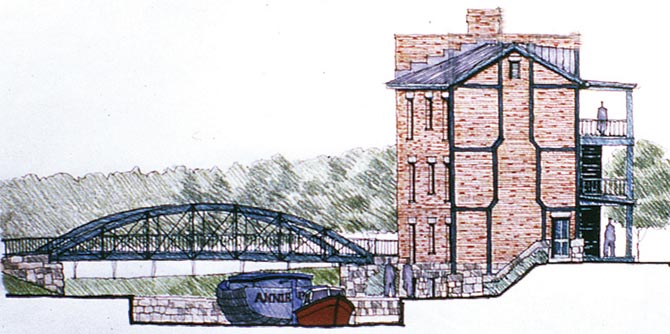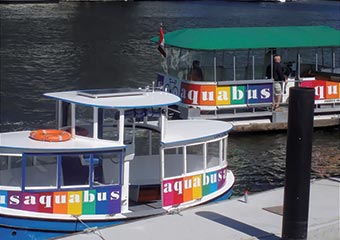Lighter, Faster, Cheaper
by Geoff Kelly

How ECHDC can start building things, attracting people to the waterfront, and scoring some wins in the short run
It may be overstating the case to say that the Erie Canal Harbor Development Corporation and its plans for Buffalo’s Inner Harbor and the surrounding parcels are in disarray. But not by much: ECHDC’s guidestar for the past six years, Bass Pro, is gone; public support for a development anchored by big-box retail, if it ever existed, seems to have evaporated; a lawsuit seeking to prevent ECHDC from handing public funds to private corporations is pending; a new governor and a continuing state budget crisis threaten to reshuffle its board members and development priorities; and a series of well attended community meetings organized by opponents of ECHDC’s current development plans seem to suggest that public sentiment has turned against both those plans and the agency.
Last Friday, ECHDC canceled two public forums it had scheduled as counterweights to the community meetings organized by its critics. (Small wonder: the first of ECHDC’s public forums was ill attended, and at least 40 of those who RSVPed to the next were members of the Canalside Community Alliance, which has been pushing ECHDC to negotiate a community benefit agreement.) On Tuesday, ECHDC announced that it would hold six “open houses” instead at its offices at 95 Perry Street over the next week.
The agency seems to be scrambling for a new direction, while insisting that it must bid out work for a faux canal and parking ramps by January—expensive proposals that proponents of the 2004 master plan abhor.
So what can ECHDC do instead of parking and faux canals? What can be done “lighter, faster, cheaper,” in the words of Fred Kent, the director of Project for Public Spaces, and developer Tony Goldman, who advocated two weeks ago for a series of smaller, less expensive measures that would promote activity in Buffalo’s Inner Harbor in the short run and attract private investment in the long run?
Here are a few ideas, none of them new, that would add quickly, cheaply, and visibly to the progress ECHDC has already made:




• Rebuild Dug’s Dive, the infamous tavern alongside the Commercial Slip which served as a station on the Underground Railroad. African Americans have rightly complained that ECHDC’s proposals contain nothing that speaks to their history, and Dug’s Dive would begin to redress that slight. The bottom floors could house a museum dedicated to the history of the region’s African-American community and the Underground Railroad. The upper floors could house a center on historic preservation and architecture and a museum dedicated to the history of immigration in the region, of which the Canal District is an important part. There are already plans drawn up for the recreation of Dug’s Dive (pictured above); the cost estimate is $2 million. The historic site of the building is technically just outside the project area ECHDC designated for itself, but that’s a bureaucratic matter. Beside, what ever stopped a state agency—the Public Bridge Authority, for example—from spending money outside its project area?
• More archeological work. The triangle of city land where the Erie Canal met Lake Erie is a designated archeological site. No one can dig for foundations or footers there without first undertaking archeological studies to determine if there’s anything of historical value there that ought to be retrieved. ECHDC has already spent money on archeology, but there’s more work to do. The digging itself could represent an ongoing attraction, as it did in Quebec City (below), and public relations campaign for the agency. Imagine people coming to watch archeologists from UB digging out sites; imagine stories in the media every time something new and interesting is uncovered. Imagine how glad private developers will be that ECHDC absorbed this site preparation cost for them.
• Build a public pavilion that makes homage to the Humboldt Park Parade House (top right) designed by Calvert Vaux.
• Continue the Central Wharf, which has already proved to be a popular destination in fair weather, all the way to the foot of Main Street.
• Consider building offshore on barges. There’s a beautiful new rowing center on the Harlem River that was built on a barge in order to avoid land-use restrictions that otherwise would have made its construction prohibitively expensive.
• If that’s too difficult, how about temporary structures—reclaimed shipping containers, perhaps—that can house vendors and artists cheaply or for free all spring, summer, and fall. Get a food vendor down there as well.
• Get a waterbus (below right) going that will travel between the Outer and Inner Harbors.
• Light it up. Take another cue from the PBA: Decorate all the local bridges, including the one over the Commercial Slip, with lights whose colors can be changed.
• Project onto the grain elevators across the Buffalo River. They are one big blank canvas. Commission artists to bathe them in light, as Quebec City has done. And use their flat surfaces for an outdoor film festival that people can enjoy from the Central Wharf or from their boats bobbing in the river.
• Book a carnival, or an outdoor arts festival, or a sports tournament for the seven acres of waterfront property next summer. Buffalo is good at hosting these.
• To support these and any other activities, you’ll need some sort of seating and public restrooms.
• While spending money on these and other initiatives that will offer visible evidence of forward motion by the beginning of next summer, and draw greater crowds by giving people things to do, take time to reimagine ECHDC’s mission: Consider the entire Ohio Street corridor that connects the Inner and Outer Harbors, drawing together Buffalo’s residential Old First Ward and downtown. Along that pathway you’ll find community partners promoting public art, historic preservation, commercial revitalization, and pocket parks whose individual potential could be realized through ECHDC’s larger vision and ample funding. Give Jay “Microparks” McCarthy $125,000 for a skate park. Link up with Riverfest Park. Tie in the Swannie House. Build on what we have, instead of trying to build a mall on the waterfront that hosts national chains and is isolated from everything surrounding it.
All these ideas and more will be discussed at greater length by entrepreneur Mark Goldman and Tim Tielman of the Campaign for Greater Buffalo History, Architecture and Culture at the Burchfield Penney Art Center tonight (Thursday, November 18, at 6pm). If you miss it, you can check out their presentations at Artvoice.com.
—geoff kelly
blog comments powered by Disqus|
Issue Navigation> Issue Index > v9n46 (Week of Thursday, November 18) > Lighter, Faster, Cheaper This Week's Issue • Artvoice Daily • Artvoice TV • Events Calendar • Classifieds |









 Current Issue
Current Issue